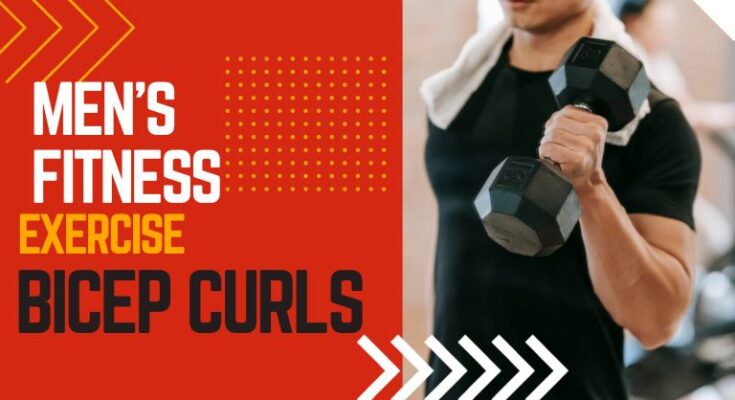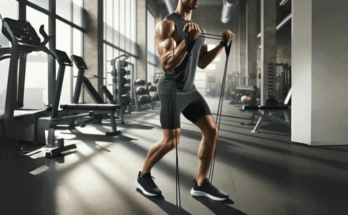DUMBBELL CURL
The dumbbell curl is a fundamental exercise that targets the biceps and helps to build upper body strength. With this exercise, you hold a dumbbell in each hand with your palms facing forward and then proceed to curl the weights up towards your shoulders. This movement primarily targets the biceps brachii, which is the large muscle at the front of the upper arm. By performing dumbbell curls regularly, you can effectively develop and strengthen the biceps, leading to improved arm definition and overall upper body aesthetics.
It is important to maintain proper form while performing dumbbell curls to maximize the benefits and minimize the risk of injury. Begin by standing with your feet shoulder-width apart and arms fully extended, holding the dumbbells at your sides. Keep your elbows close to your sides and engage your core for stability. As you curl the weights upwards, exhale and focus on contracting the biceps. Pause briefly at the top, then slowly lower the dumbbells back down to the starting position. Remember to maintain control throughout the entire movement and avoid swinging or using momentum to lift the weights. By following these guidelines, you can effectively engage your biceps and achieve optimal results with the dumbbell curl.

How to do bicep curls with dumbbells:
- Hold a dumbbell in each hand with your palms facing forward.
- Stand up straight with your feet shoulder-width apart.
- Bend your elbows and curl the dumbbells up towards your shoulders.
- Hold for a second at the top of the movement, then slowly lower the dumbbells back to the starting position.
- Repeat for the desired number of reps.
Benefits of bicep curls with dumbbells:
Bicep curls are a great way to build and strengthen the biceps muscle group. They can also help to improve upper body strength and definition.
DOUBLE ARM DUMBBELL CURL
The double arm dumbbell curl is a popular exercise among fitness enthusiasts and bodybuilders looking to build stronger and more defined biceps. This exercise involves holding a dumbbell in each hand with an underhand grip and curling the weights up towards the shoulders. By performing this exercise, you target the biceps brachii muscles, which are responsible for flexing the elbow joint.
To properly execute the double arm dumbbell curl, it is essential to maintain proper form and technique. Begin by standing with your feet shoulder-width apart and a dumbbell in each hand. Keep your elbows tucked in close to your sides and fully extend your arms, allowing the dumbbells to hang at arm’s length. As you curl the weights up, focus on contracting your biceps and avoiding any swinging or momentum. Remember to breathe throughout the movement and exhale as you bring the dumbbells up towards your shoulders. By incorporating the double arm dumbbell curl into your workout routine, you can effectively strengthen and sculpt your biceps for a more chiseled and muscular appearance.

Here are some tips on how to perfect your form for dumbbell curls:
- Start with a comfortable weight: Select a weight that you can comfortably lift for the desired number of reps. It’s better to start with a lighter weight and work your way up, rather than using a weight that’s too heavy and sacrificing form.
- Stand with proper posture: Stand up straight with your feet shoulder-width apart and your shoulders back. This will help to maintain proper alignment and engage your core.
- Hold the dumbbells correctly: Hold the dumbbells with a neutral grip (palms facing inward) and keep your wrists straight. Avoid using a grip that’s too tight, as this can cause unnecessary strain on the wrists.
- Keep your elbows close to your sides: Keep your elbows close to your sides throughout the movement. This will help to isolate the biceps and prevent swinging.
- Curl one arm at a time: Start by curling one dumbbell towards your shoulder, keeping your elbow close to your side. As you lift the weight, focus on squeezing your bicep at the top of the movement.
- Lower the weight in a controlled manner: Lower the weight back down in a controlled manner, making sure to keep your elbow close to your side. Avoid letting the weight drop quickly, as this can put unnecessary strain on the joints.
- Alternate between arms: Once you have completed a full rep with one arm, switch to the other arm and repeat the exercise.
- Breathe properly: Inhale as you lower the weight and exhale as you curl the weight towards your shoulder.
Dumbbell Curl Benefits
Dumbbell curls are a versatile exercise that offers a variety of benefits, including:
- Increased muscle size: Dumbbell curls are an effective exercise for building muscle mass in the biceps. By progressively increasing the weight or resistance, you can activate more muscle fibers and stimulate muscle growth over time.
- Improved muscle strength: Dumbbell curls can also help improve muscle strength in the biceps. By challenging the muscles with heavier weights or resistance, you can increase muscle activation and promote the development of stronger, more resilient muscle fibers.
- Enhanced muscle endurance: Dumbbell curls can also improve muscle endurance in the biceps. By performing higher repetitions or multiple sets of the exercise, you can challenge the muscles to sustain exertion for longer periods, ultimately improving overall muscle endurance.
- Improved functional strength: Stronger biceps muscles can improve overall functional strength, helping you perform everyday tasks with greater ease and efficiency. For example, lifting heavy objects or carrying groceries can be much easier with strong biceps muscles.
- Improved grip strength: Dumbbell curls can also improve grip strength, as the exercise requires a strong grip to hold onto the weights. Improved grip strength can translate to improved performance in activities that require a strong grip, such as rock climbing or gymnastics.
Dumbbell Curl Muscles Worked
The dumbbell curl primarily targets the biceps muscles, with the brachialis and brachioradialis muscles acting as synergists. The wrist flexors also act as stabilizers to help control the movement of the weight. Here is a breakdown of the muscles worked during dumbbell curls:
- Biceps brachii: The biceps brachii is a two-headed muscle that is located at the front of the upper arm. It is responsible for flexing the elbow and rotating the forearm.
- Brachialis: The brachialis is a muscle that is located beneath the biceps brachii. It is also responsible for flexing the elbow.
- Brachioradialis: The brachioradialis is a muscle that is located on the outside of the forearm. It is responsible for flexing the wrist and rotating the forearm.
- Wrist flexors: The wrist flexors are a group of muscles that are located on the underside of the forearm. They are responsible for flexing the wrist.
CONCENTRATION CURL
The concentration curl is a crucial exercise in any arm workout routine, specifically targeting the biceps muscles. This exercise is performed while sitting on a bench with a dumbbell in one hand. By isolating the bicep muscle, the concentration curl enables you to achieve a better mind-muscle connection, focusing all your attention on the targeted area.
To correctly execute the concentration curl, start by sitting upright on the bench with your legs slightly wider than shoulder-width apart. Place your working arm’s elbow on the inside of your thigh, ensuring that your hand hangs straight down in front of your body. Hold a dumbbell with an underhand grip, keeping your core engaged and your back straight. Slowly raise the dumbbell towards your shoulder while exhaling, making sure to keep your upper arm stationary. Pause for a brief moment at the top of the motion and squeeze your bicep before slowly lowering the weight back to the starting position, inhaling as you do so. Repeat for the desired number of repetitions and then switch to the other arm.
Incorporating the concentration curl into your arm training routine maximizes the development of your biceps, enhancing both strength and aesthetics. Remember to start with a weight that challenges you but allows for proper form to avoid injury. Additionally, focus on proper breathing and control throughout each repetition to optimize the effectiveness of this exercise.

How to Use
To perform a concentration curl, follow these steps:
- Sit on a bench or chair with your feet flat on the ground and a dumbbell in one hand.
- Place your elbow on the inside of your thigh, with your arm fully extended and the dumbbell hanging straight down.
- Curl the weight up towards your shoulder, keeping your elbow stationary and your upper arm pressed against your thigh.
- Pause at the top of the movement, then slowly lower the weight back down to the starting position.
- Repeat for the desired number of repetitions, then switch to the other arm and repeat.
Some Tips for proper form:
- Keep your elbow stationary throughout the exercise to maximize bicep activation.
- Focus on squeezing your bicep at the top of the movement to fully contract the muscle.
- Keep your upper arm pressed against your thigh to prevent swinging and cheating.
- Use a controlled and slow movement, rather than jerking the weight up and down.
- Exhale as you curl the weight up, and inhale as you lower it down.
Concentration Curl Benefits
Concentration curls performed with one arm at a time have several benefits, including:
- Greater muscle activation and hypertrophy: When you do concentration curls with one arm, you can focus all of your attention on that arm, which can lead to greater muscle activation and growth.
- Improved symmetry: If you have one arm that is stronger than the other, performing concentration curls unilaterally can help to improve symmetry by working each arm independently.
- Better grip strength: Holding a weight in one hand requires a strong grip, and doing concentration curls unilaterally can help to improve grip strength and forearm development.
- Improved mind-muscle connection: Focusing on one arm at a time can help to improve the mind-muscle connection, which can help you to maximize muscle activation and growth.
- Reduced risk of injury: Concentration curls performed unilaterally can help to reduce the risk of injury by ensuring that each arm is working independently and with proper form.
Overall, performing concentration curls unilaterally is a great way to target and develop your biceps, as well as address any muscle imbalances or weaknesses.
Here is a simpler explanation:
Doing concentration curls with one arm at a time is better than doing them with both arms at the same time because:
- It allows you to focus more on each arm and get a better workout.
- It helps to improve symmetry between your left and right arms.
- It helps to improve your grip strength.
- It helps to improve your mind-muscle connection, which means you can better control your muscles and get more out of your workouts.
- It reduces your risk of injury.
HAMMER CURL
The hammer curl is a highly effective exercise that targets the brachialis and brachioradialis muscles in the arms. By gripping the dumbbells in a neutral position, with the palms facing each other, this exercise places emphasis on these muscles, helping to build overall arm strength and size. The hammer curl also engages the biceps and forearms to a lesser extent, making it a versatile and functional movement that can be performed by individuals of all fitness levels.
When performing the hammer curl, it is important to maintain proper form and control throughout the exercise. Start by standing or sitting with a dumbbell in each hand, arms fully extended and palms facing towards the body. Keeping the elbows close to the sides, slowly curl the dumbbells towards the shoulders, contracting the biceps and forearms at the top of the movement. Lower the dumbbells back down in a controlled manner, without allowing the momentum to take over. Aim to perform the hammer curl with a steady and deliberate pace, focusing on feeling the muscles working throughout the entire range of motion.

How to do:
- Stand or sit with good posture, holding a dumbbell in each hand with a neutral grip, palms facing each other. Your arms should be fully extended and hanging by your sides.
- Curl one arm at a time. As you breathe out, curl one weight towards your shoulder, keeping the other weight extended and hanging by your side.
- At the top of the movement, squeeze your biceps to fully contract the muscles.
- As you breathe in, slowly lower the weight back to the starting position, keeping your elbow close to your body and maintaining control throughout the movement.
- Repeat the movement with your other arm, curling the weight towards your shoulder while keeping the other arm extended and hanging by your side.
- Continue alternating arms, curling one weight at a time while keeping the other arm extended and hanging by your side.
Hammer Curl Benefits
The hammer curl is a weight training exercise that targets the brachioradialis muscle, which is a muscle in the forearm that is responsible for elbow flexion and wrist rotation. The hammer curl is also a good exercise for the biceps muscle and the brachialis muscle in the upper arm.
The hammer curl is performed with a neutral grip, which means that the palms of the hands face each other. This grip position places a greater emphasis on the brachioradialis muscle than a traditional bicep curl, which is performed with a supinated grip (palms facing up).
To perform a hammer curl, stand with your feet shoulder-width apart and hold a dumbbell in each hand with a neutral grip. Curl the dumbbells up towards your shoulders, keeping your elbows close to your sides. At the top of the movement, your thumbs should be close to your shoulders and your palms should be facing each other. Slowly lower the dumbbells back to the starting position.
The hammer curl is a versatile exercise that can be incorporated into a variety of workout routines. It is a good exercise for beginners and experienced lifters alike. Here are some of the benefits of performing hammer curls:
- Increased upper arm strength and size
- Improved grip strength
- Reduced risk of injury
- Improved forearm stability and wrist rotation
- Enhanced functional strength for activities of daily living
SEATED INCLINE DUMBBELL CURL
The seated incline dumbbell curl is a highly effective exercise that targets the biceps and helps to increase overall upper body strength. This exercise is performed on an incline bench, with the backrest set at approximately a 45-degree angle. By sitting on the bench and positioning the weights at arm’s length, individuals can isolate the biceps muscles and ensure proper form throughout the movement.
The seated incline dumbbell curl primarily works the biceps brachii, which is the largest muscle in the front of the upper arm. This exercise also recruits the brachialis muscle, which lies underneath the biceps and contributes to the overall size and definition of the arm. By maintaining a seated position and utilizing dumbbells instead of a barbell, individuals can achieve a greater range of motion and engage their stabilizer muscles, leading to enhanced muscle development and improved strength. Incorporating the seated incline dumbbell curl into your workout routine can help you achieve well-rounded biceps and increase the overall aesthetic appeal of your upper body.

How to do:
Here are some tips for performing a dumbbell bicep curl with proper form, rewritten in new wordings:
- Set up: Adjust the bench to a 45-degree incline, and make sure it’s stable. Sit on the bench with your back straight and your feet flat on the floor.
- Weight: Choose a weight that’s right for you. Start light and gradually increase it as you get stronger.
- Grip: Hold a dumbbell in each hand with your palms facing up. Grip the dumbbells comfortably and firmly.
- Arm position: Extend your arms fully and keep them parallel to the floor. Keep your elbows close to your body.
- Curl: Slowly lift one dumbbell towards your shoulder, keeping your elbow stationary. As you lift the dumbbell, rotate your palm so that it’s facing your shoulder at the top of the movement. While lowering the first dumbbell, start lifting the other dumbbell and rotate your other palm so that it’s also facing your shoulder at the top of the movement.
- Breath: Inhale as you lower the dumbbells and exhale as you lift them.
- Control: Throughout the exercise, focus on maintaining control and avoiding any swinging or jerking motions. Use a slow and controlled movement to engage your muscles fully.
Here are some additional tips:
- Keep your core engaged throughout the exercise.
- Avoid arching your back.
- Don’t use momentum to lift the dumbbells.
- Squeeze your biceps at the top of the movement.
- Lower the dumbbells slowly and with control.
If you’re new to dumbbell bicep curls, it’s a good idea to have a personal trainer or other experienced lifter teach you proper form. This will help you avoid injury and get the most out of the exercise.



